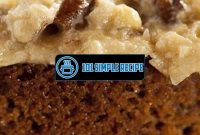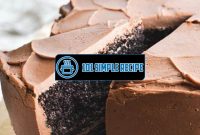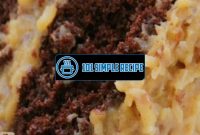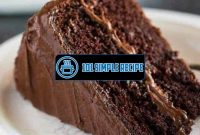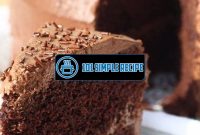Welcome to your guide on how to create a deliciously simple chocolate cake at home! Whether you’re a beginner in the kitchen or a seasoned baker, this recipe is sure to satisfy your sweet tooth and impress your friends and family. With just a few basic ingredients and easy-to-follow instructions, you’ll be able to whip up a moist and decadent chocolate cake that will have everyone asking for seconds. So, roll up your sleeves, preheat your oven, and let’s get baking!

The History of Chocolate
Chocolate, a delectable treat loved by people all over the world, has a rich and fascinating history. From its humble beginnings in ancient civilizations to its transformation into the beloved confectionary we know today, chocolate has come a long way.
The Discovery of Chocolate
The story of chocolate begins in the tropical rainforests of Central and South America. It is said that the ancient Mayans and Aztecs first discovered the cacao tree, which produces the beans used to make chocolate. The cacao beans were highly prized and used as currency. The Mayans even worshipped a god of cacao.
Legend has it that the Spanish conquistador Hernán Cortés was the first European to encounter cacao when he arrived in Mexico in the early 16th century. The Aztec ruler Montezuma II served Cortés a frothy, bitter drink made from ground cacao beans, honey, and spices. Cortés brought this newfound treasure back to Europe, sparking interest in cacao and setting the stage for chocolate’s journey across the continent.
Chocolate in Ancient Civilizations
In ancient civilizations, chocolate was not just a delicious treat but also had cultural and religious significance. The Mayans and Aztecs believed that cacao beans possessed mystical properties and used them in various ceremonies and rituals. They also used cacao to create a bitter beverage known as “xocoatl,” which was believed to have various medicinal benefits.
Chocolate remained a sacred drink reserved for the elite in ancient civilizations. It wasn’t until the Spanish began adding sugar and other flavorings to the bitter drink that chocolate started to become more widely enjoyed.
The Introduction of Chocolate to Europe
When chocolate arrived in Europe, it quickly gained popularity among the nobility. However, it was still consumed primarily as a beverage. The Spanish introduced chocolate to the royal courts, and soon it became a fashionable drink enjoyed by the aristocracy.
In the 18th century, advancements in technology led to the development of solid chocolate. This made it easier for people to enjoy chocolate in various forms. Chocolate houses also started to emerge, where people could gather to socialize and indulge in this delightful treat.
The Industrial Revolution brought further innovations to the chocolate industry. The invention of the cocoa press in the 19th century made it possible to produce cocoa powder, which was used to make chocolate bars and other confections. This led to the mass production of chocolate and made it more accessible to the general public.
In Summary
The history of chocolate is a testament to the enduring appeal of this delightful treat. From its discovery in ancient civilizations to its introduction to Europe, chocolate has captivated the taste buds of people around the world. Whether enjoyed as a beverage or in the form of a decadent dessert, chocolate continues to bring joy and sweetness to our lives.
The Science Behind Baking
Do you ever wonder what makes a chocolate cake so deliciously irresistible? It’s not just the taste but also the science behind baking that plays a crucial role in creating this delectable dessert. Understanding the chemical reactions and principles involved can help you become a master cake baker. So, let’s delve into the fascinating world of baking!
Baking is a combination of art and science. It involves a series of chemical reactions that transform simple ingredients into a delectable treat. The main reactions that occur during baking include protein denaturation, starch gelatinization, sugar caramelization, and leavening agent activation.
Protein denaturation is crucial in baking as it gives structure and texture to the cake. When the cake batter is mixed, the proteins in the eggs and flour unfold and coagulate during the baking process. This creates a stable structure that gives the cake its soft and fluffy texture.
Starch gelatinization occurs when the cake is baked, and heat is applied. Starch, which is present in flour, absorbs the liquid in the batter and swells, creating a gel-like structure. This helps the cake hold its shape and gives it a tender crumb.
Sugar plays a dual role in baking. It adds sweetness and also contributes to the browning of the cake through the Maillard reaction. The Maillard reaction occurs when the sugars react with proteins and amino acids, resulting in the desirable golden brown color and rich flavor of the cake.
Now, let’s talk about the leavening agents that make the cake rise. Baking powder and baking soda are commonly used leavening agents in cake recipes. These agents create bubbles of carbon dioxide gas, which get trapped in the cake batter. As the cake bakes, the gas expands, causing the cake to rise and become light and airy.
The Role of Ingredients in Baking
The ingredients used in baking are of paramount importance. Each ingredient serves a specific purpose in creating the perfect chocolate cake. Let’s take a closer look at some key ingredients:
- Flour: Flour provides the structure and stability to the cake. It contains proteins that form gluten when mixed with liquids, giving the cake its structure.
- Sugar: Sugar not only adds sweetness but also helps in the tenderization and browning of the cake. It also enhances the flavor and contributes to the moistness of the cake.
- Eggs: Eggs act as a binding agent and provide moisture to the cake. They also contribute to the structure and texture of the cake through protein denaturation.
- Butter: Butter adds richness, flavor, and moisture to the cake. It also helps in the tenderization of the cake by reducing gluten formation.
- Milk: Milk adds moisture and tenderness to the cake. It also helps in the dissolution of dry ingredients and provides a smoother texture to the batter.
Baking Powder vs. Baking Soda
Baking powder and baking soda are leavening agents that help the cake rise. However, they differ in their composition and reaction mechanisms.
Baking powder is a mix of baking soda, an acid (usually cream of tartar), and a drying agent (usually cornstarch). When combined with liquid, baking powder releases carbon dioxide, causing the cake to rise. It is usually used in recipes that do not contain any acidic ingredients.
On the other hand, baking soda (sodium bicarbonate) is an alkaline compound that requires an acidic ingredient (such as buttermilk, vinegar, or lemon juice) to activate its leavening properties. The acid reacts with baking soda to release carbon dioxide, resulting in the rise of the cake.
The Magic of Cocoa Powder
Cocoa powder is the star ingredient that gives the chocolate cake its rich, chocolatey flavor. Made from roasted and ground cocoa beans, cocoa powder adds depth and complexity to the taste of the cake.
Not only does cocoa powder provide flavor, but it also contributes to the texture of the cake. It absorbs moisture from the batter, making the cake denser and fudgier. To achieve a well-balanced chocolate flavor, it’s essential to use high-quality cocoa powder.
So, the next time you bake a chocolate cake, remember the important role that each ingredient and the science behind baking play in creating a deliciously simple masterpiece. Embrace the chemistry and enjoy the mouthwatering results!
Homemade chocolate sauce recipe
Mastering the Art of Simple Chocolate Cake
In this article, you will learn the step-by-step process of baking a decadent chocolate cake with ease. From preparing the perfect cake batter to mastering baking and cooling techniques, as well as frosting and decorations, we’ve got you covered.
The Perfect Cake Batter
The key to creating a deliciously simple chocolate cake begins with the perfect cake batter. Start by gathering all the necessary ingredients, such as flour, sugar, cocoa powder, baking powder, salt, eggs, milk, vegetable oil, and vanilla extract.
To ensure a smooth texture, sift together the dry ingredients in a large mixing bowl. This will help eliminate any lumps and ensure even distribution. In a separate bowl, whisk together the wet ingredients until well combined. Gradually add the dry ingredients to the wet mixture, stirring gently until just combined. Be careful not to overmix as this can result in a dense cake.
For an extra touch of flavor, consider adding in some chocolate chips or chopped nuts to the batter. This will add a delightful texture and surprise your taste buds with each bite.
Baking and Cooling Techniques
Once you have prepared the cake batter, it’s time to bake it to perfection. Preheat your oven to the recommended temperature found in your recipe. Grease and flour your cake pans to prevent sticking.
Divide the batter evenly between the pans, ensuring that they are filled no more than two-thirds full. This will allow room for the cake to rise without overflowing. Place the pans in the center of the oven and bake for the specified time. Avoid opening the oven door too often as this can cause the cake to sink in the middle.
After the baking time is up, insert a toothpick into the center of the cake. If it comes out clean or with a few crumbs, the cake is ready. Remove the pans from the oven and let them cool on a wire rack for about 10-15 minutes. Gently remove the cakes from the pans and allow them to cool completely before frosting.
For a moist and tender cake, wrap each layer in plastic wrap and place them in the refrigerator for a couple of hours or even overnight. This will help the flavors meld together and make it easier to frost.
Frosting and Decorations
The final step in creating your deliciously simple chocolate cake is the frosting and decorations. Choose your preferred frosting, whether it’s a classic buttercream, rich ganache, or a fluffy cream cheese frosting.
Start by applying a thin layer of frosting on top of one cake layer, then place the second layer on top. Use a spatula to spread a generous amount of frosting on the top and sides of the cake. Smooth out any excess frosting for a clean finish.
Now comes the fun part, decorating your cake! Consider adding chocolate shavings, sprinkles, fresh fruit, or edible flowers for an extra touch of beauty and flavor. Let your creativity shine as you create a cake that will impress your friends and family.
Remember, practice makes perfect. Don’t be discouraged if your first attempt is not picture-perfect. With time and experience, you will become a master of baking deliciously simple chocolate cakes. Enjoy the process and savor every bite of your homemade creation!
Customizing Your Chocolate Cake
When it comes to making a deliciously simple chocolate cake at home, the opportunities for customization are endless. By adding your own unique twists and flavors, you can create a cake that is truly one-of-a-kind. Here are some creative ideas to help you customize and elevate your chocolate cake:
Adding Nuts and Fruits
One way to take your chocolate cake to the next level is by incorporating nuts and fruits. Not only do they add a delightful crunch and burst of flavor, but they also provide added texture and visual appeal. Consider adding chopped walnuts, almonds, or hazelnuts to the cake batter for a nutty surprise. If you’re a fan of fruity flavors, try mixing in fresh berries like strawberries, raspberries, or blueberries. These additions will not only enhance the taste but also make your cake look more vibrant and appealing.
Exploring Different Frosting Flavors
The frosting is an essential element that can instantly transform a plain chocolate cake into a delectable treat. Don’t limit yourself to traditional chocolate frosting; instead, experiment with different flavors to add excitement and variety. For a tangy twist, consider a cream cheese frosting with a hint of lemon zest. If you’re a fan of rich and indulgent flavors, try a decadent chocolate ganache or a velvety caramel frosting. You can even opt for a light and fluffy whipped cream frosting for a refreshing contrast. The choice of frosting can dramatically enhance the overall taste and make your chocolate cake truly unforgettable.
Experimenting with Fillings and Layers
Why settle for a basic chocolate cake when you can have multiple layers and mouthwatering fillings? Get creative by experimenting with different combinations to create a cake that surprises and delights with every bite. Consider adding a layer of creamy peanut butter or Nutella between the cake layers for an irresistible twist. You can also infuse flavor by incorporating fruit preserves like raspberry or cherry. For those who love a bit of crunch, sprinkle some crushed cookies or granola between each layer. Don’t be afraid to mix and match different fillings to create a cake that reflects your unique taste and style.
Overall, customizing your chocolate cake is a fun and rewarding experience. By adding nuts and fruits, exploring different frosting flavors, and experimenting with fillings and layers, you can create a cake that not only tastes amazing but also showcases your personal touch. So, get creative and let your imagination run wild as you indulge in the process of creating your very own deliciously simple chocolate cake.
Troubleshooting Common Chocolate Cake Issues
Addressing common problems that may arise during the baking process and providing solutions will ensure you create a deliciously simple chocolate cake at home. Let’s dive into some troubleshooting tips for dealing with dry cakes, making up for overly moist cakes, and solving sinking or cracked cakes.
Dealing with Dry Cakes
When you’re craving a moist and heavenly chocolate cake, a dry result can be disappointing. Here’s how you can combat this issue:
1. Measure Your Ingredients Correctly: Accurate measurements of flour, sugar, butter, and liquids are crucial. Using a kitchen scale is the best way to ensure precise measurements.
2. Add Moisturizing Ingredients: Incorporating additional moist ingredients into your cake batter can help counteract dryness. Consider including ingredients like sour cream, buttermilk, or yogurt to enhance moisture.
3. Adjust Baking Time and Temperature: Overbaking can lead to dry cakes. Keep a close eye on your cake during the baking process and use a toothpick or cake tester to check for doneness. If the cake is dry, reduce the baking time or lower the oven temperature slightly.
4. Syrup or Soak the Cake: If your cake turns out dry, you can revive it by adding a simple syrup or soaking it with flavored liquids like coffee or fruit juice. This will infuse moisture into the cake and enhance its taste.
Remember, even if your cake turns out slightly dry, you can always pair it with a luscious frosting or serve it with a scoop of ice cream to enhance its overall texture and taste.
Making up for Overly Moist Cakes
While dry cakes can be disappointing, overly moist ones can be equally problematic. Here’s what you can do to rectify this situation:
1. Adjust the Recipe: If you consistently end up with overly moist cakes, consider altering the recipe slightly. Reduce the amount of liquid ingredients, such as milk or water, and increase the amount of dry ingredients like flour, cocoa powder, or baking powder.
2. Increase Baking Time and Temperature: If your cake is overly moist but cooked through, extending the baking time can help evaporate excess moisture. However, be cautious not to overbake it, as it may result in the cake becoming dry instead.
3. Use a Cooling Rack: After removing the cake from the oven, let it cool on a wire rack instead of leaving it in the baking pan. This allows air to circulate around the cake, preventing excess moisture from accumulating.
4. Ensure Proper Storage: Moisture can seep into cakes during storage, making them even more moist. Store your cake in an airtight container once it has cooled completely. If the cake is too moist, placing a paper towel in the container can help absorb excess moisture.
Solving Sinking or Cracked Cakes
Nothing is more disheartening than seeing your beautifully baked cake collapse or develop unsightly cracks. Here are some tips to prevent sinking or cracking:
1. Properly Measure Leavening Agents: Too much or too little baking powder or baking soda can cause cakes to sink. Always use the specified amount mentioned in the recipe for optimal results.
2. Be Mindful of Excessive Mixing: Overmixing your cake batter can lead to excessive air incorporation, which may cause the cake to rise too quickly and then sink. Mix the ingredients until just combined to avoid this issue.
3. Check Oven Temperature Accuracy: An oven that runs too hot or too cold can affect the rise and structure of your cake. Use an oven thermometer to ensure your oven is calibrated correctly.
4. Avoid Opening the Oven Door Too Early: Opening the oven door prematurely can cause the cake to sink. Wait until the cake is almost fully baked before checking for doneness through the oven window or by using a toothpick.
By following these troubleshooting tips, you’ll be equipped to overcome common chocolate cake issues and create a moist and delectable treat every time. Enjoy your homemade chocolate cake, and happy baking!
Thank you for reading our simple chocolate cake recipe! We hope you enjoyed learning how to make this delicious dessert. Don’t forget to bookmark this page so you can come back and make this cake again later. With its moist chocolatey goodness, it’s sure to be a hit at any gathering or as a special treat for yourself. Happy baking!
Frequently Asked Questions
Here are some common questions that readers have about our simple chocolate cake recipe:
| No. | Questions | Answers |
|---|---|---|
| 1. | What type of chocolate should I use for the cake? | You can use any high-quality chocolate that you prefer. We recommend using semi-sweet or dark chocolate for a rich chocolate flavor. |
| 2. | Can I add nuts or other toppings to the cake? | Absolutely! Feel free to customize your chocolate cake with your favorite nuts, sprinkles, or even fresh fruit. |
| 3. | Can I substitute butter with oil? | Yes, you can substitute butter with an equal amount of vegetable oil. This will result in a slightly different texture, but the cake will still be delicious. |
| 4. | How should I store the leftover cake? | You can store the leftover cake in an airtight container at room temperature for up to 3 days, or in the refrigerator for up to a week. Just make sure to bring it to room temperature before serving. |
| 5. | Can I freeze the cake? | Yes, you can freeze the cake! Wrap it tightly in plastic wrap and place it in a freezer-safe bag or container. It can be frozen for up to 3 months. Thaw it in the refrigerator overnight before serving. |
| 6. | Can I make cupcakes instead of a cake? | Absolutely! This recipe can be easily adapted to make delicious chocolate cupcakes. Just adjust the baking time accordingly. |
Thank You and Visit Again!
We hope you enjoyed this simple chocolate cake recipe and found it easy to follow. We’ll be back with more delicious recipes soon, so be sure to check back regularly. Until then, happy baking!
Jump to Recipe
Simple Chocolate Cake Recipe

Learn how to make a simple, moist, and delicious chocolate cake with this easy recipe.
- 1 and 3/4 cups all-purpose flour
- 1 and 1/2 cups granulated sugar
- 3/4 cup unsweetened cocoa powder
- 1 and 1/2 teaspoons baking powder
- 1 and 1/2 teaspoons baking soda
- 1 teaspoon salt
- 2 large eggs
- 1 cup milk
- 1/2 cup vegetable oil
- 2 teaspoons vanilla extract
- 1 cup boiling water
- Preheat the oven to 350°F (175°C). Grease and flour two 9-inch round cake pans.
- In a large mixing bowl, whisk together the flour, sugar, cocoa powder, baking powder, baking soda, and salt.
- Add the eggs, milk, oil, and vanilla extract to the dry ingredients. Mix well until fully combined.
- Carefully add the boiling water to the batter. Stir until the batter is smooth.
- Divide the batter evenly between the prepared cake pans. Bake in the preheated oven for 30 to 35 minutes, or until a toothpick inserted into the center comes out clean.
- Allow the cakes to cool in the pans for 10 minutes, then transfer them to a wire rack to cool completely. Frost the cakes with your favorite chocolate frosting.

